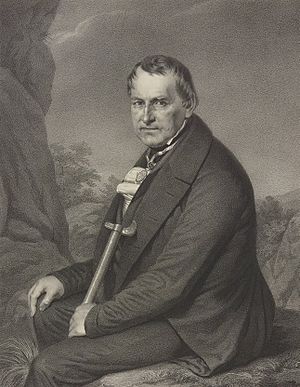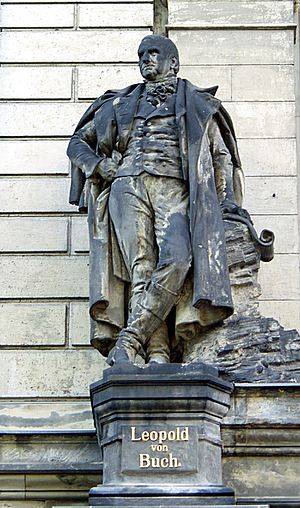Christian Leopold von Buch facts for kids
Quick facts for kids
Christian Leopold von Buch
|
|
|---|---|

Christian Leopold von Buch, by Carl Joseph Begas (1850)
|
|
| Born | 26 April 1774 |
| Died | 4 March 1853 (aged 78) |
| Nationality | German |
| Known for | Jurassic System Andesite Magma mixing Elevation crater theory |
| Awards | Wollaston Medal (1842) |
| Scientific career | |
| Fields | Geology |
Christian Leopold von Buch (born April 26, 1774 – died March 4, 1853) was a very important German geologist and paleontologist. He was born in Stolpe an der Oder, which is now part of Angermünde, Germany. Leopold von Buch is known as one of the most important scientists in geology during the early 1800s.
He was interested in many different areas of geology. These included volcanism (how volcanoes work), petrology (the study of rocks), fossils, stratigraphy (the study of rock layers), and mountain formation. One of his most famous achievements was officially defining the Jurassic System. This is a time period in Earth's history known for dinosaurs.
Contents
About Leopold von Buch
Leopold von Buch studied at the mining school in Freiberg, Saxony. His teachers included Abraham Gottlob Werner. He also studied with Alexander von Humboldt, who became a famous explorer and scientist. After Freiberg, he continued his education at the universities of Halle and Göttingen.
Exploring Germany and Italy
Leopold von Buch started writing about geology when he was young. One of his early books was about the minerals of Landeck in 1797. In 1802, he wrote about the geology of Silesia. At first, he strongly believed in the "Neptunian theory" by his teacher Werner. This theory suggested that all rocks, even volcanic ones, formed in water.
However, his travels began to change his mind. In 1797, he explored the Alps with Alexander von Humboldt. In 1798, he traveled to Italy. There, he started to doubt the Neptunian theory. He began to think that some rocks, like basalt, were formed by volcanoes, not water.
In 1799, he saw Vesuvius, a famous volcano, for the first time. In 1805, he saw it erupt with Humboldt and another scientist named Gay Lussac. This eruption helped him prove that many ideas about volcanoes at the time were wrong. In 1802, he also studied old volcanoes in Auvergne, France. Seeing the volcanic cones and lava flows there made him completely give up Werner's water-based theory for these rocks. He shared his findings from these trips in his book Geognostische Beobachtungen.
In 1806, Buch traveled to Scandinavia (Norway and Sweden). He spent two years studying the land there. He made important observations about plants, climate, and geology. He noticed that many large rocks found in northern Germany came from Scandinavia. These rocks were moved by glaciers.
He also discovered that the entire country of Sweden was slowly rising out of the sea. This process is still happening today.
Exploring the Canary Islands
In 1815, Buch visited the Canary Islands with a botanist named Christen Smith. These islands are volcanic. His time there helped him deeply study how volcanoes work. He wrote an important book about it called Physical Description of the Canary Isles (1825).
He realized that these islands and other islands in the Atlantic Ocean were created by powerful volcanic activity. He also visited two large volcanic craters, or "calderas," on the islands of Tenerife and La Palma. When he wrote about his trip, he introduced the Spanish word "Caldera" (meaning "bowl") into geology. This word is now used worldwide to describe large volcanic craters. After his trip to the Canaries, he visited volcanic areas in Hebrides, Scotland, and Ireland.
Leopold von Buch continued his geological travels even when he was very old. Just eight months before he passed away, he visited the mountains of Auvergne again. Alexander von Humboldt, who knew him for over 60 years, called him the greatest geologist of his time. Buch never married and spent his life dedicated to science. He always explored on foot, carrying his tools and papers in his coat pockets.
Ideas on Evolution
Charles Darwin, famous for his theory of evolution, mentioned Leopold von Buch in his book On the Origin of Species. Darwin noted that von Buch believed that different types of living things could slowly change into new, permanent species. These new species would then be unable to breed with the original ones.
A scientist named Ernst Mayr also said that Leopold von Buch was the first person to suggest "geographic speciation" in 1825. This idea means that new species can form when groups of animals or plants are separated by geography, like mountains or oceans.
Awards and Memberships
Leopold von Buch received many honors for his work:
- In 1825, he became a foreign member of the Royal Swedish Academy of Sciences.
- In 1849, he was elected an Honorary Member of the American Academy of Arts and Sciences.
- He received the Pour le Mérite award for Sciences and Arts.
- He was the first foreign member elected to the Geological Society of London.
- The German Geological Society (DGG) named an award, the Leopold-von-Buch-Plakette, after him.
Important Works
Here are some of the important books and papers Leopold von Buch wrote:
- On the Ammonites (1832) - about ancient sea creatures
- On the Terebratulae (1834) - about a type of brachiopod fossil
- On the Ceratites (1841) - about another type of ancient sea creature
- On the Cystidae (1845) - about a group of ancient sea animals
Other notable works include:
- Geological Map of Germany (1832) - a detailed map showing Germany's geology
- Über den Jur in Deutschland (1839) - about the Jurassic rock formations in Germany


